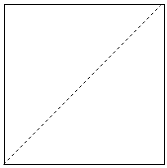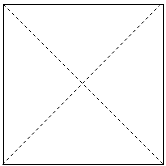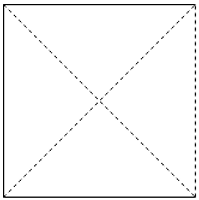This set of Class 8 Maths Chapter 3 Multiple Choice Questions & Answers (MCQs) focuses on “Quadrilaterals – Diagonals”.
1. A/An __________ is a line segment connecting two non-consecutive vertices of a polygon.
a) diagonal
b) side
c) median
d) altitude
View Answer
Explanation: When a line segment joins two vertices which are not placed besides each other, it is known as a diagonal. There should always be a vertex between the two vertices which join the diagonal. For example, in the below figure, the dotted line represents the diagonal for the square, whereas the solid lines cannot be considered as the diagonals because there is no vertex between them.

2. If two diagonals of a square intersect, what would be the angle of intersection?
a) 45°
b) 180°
c) 90°
d) 120°
View Answer
Explanation: The diagonals of any square are perpendicular bisectors of each other. So, the angle between the diagonals would be 90°. The diagram of any square with two diagonals would be like this.

3. How many diagonals can be drawn to a closed curve?
a) ∞
b) 1
c) 2
d) 0
View Answer
Explanation: In a closed curve there (as shown in the diagram below), there are no vertex. Since there are no vertex in any closed curves, there won’t be any diagonals. Hence, zero diagonals.

4. Which of the following quadrilaterals has two pairs of adjacent sides equal and diagonals intersecting at right angles?
a) Rhombus
b) Parallelogram
c) Square
d) Kite
View Answer
Explanation: The quadrilateral which has it’s adjacent sides equal, one can think of two such polygons, they are square and kite. The second condition given is the diagonals intersect at right angles which is true for both square and kite. Among kite and square, kite has adjacent sides equal whereas square has all 4 sides equal, the correct answer would be kite.
5. How many diagonals does a triangle have?
a) ∞
b) 1
c) 3
d) 0
View Answer
Explanation: Triangle has only three sides, it cannot form any diagonals. As diagonals are formed by figure which have four or more sides. Since it is not possible to draw a diagonal in a triangle ∴ the correct option would be 0.
6. Which of the following is correct?
a) The diagonals of kite bisect each other at 90°
b) The diagonals of kite bisect each other
c) The diagonals of kite make a right angle with each other
d) The diagonals of kite make an angle of 45° with each other
View Answer
Explanation: A kite is a quadrilateral which has its two adjacent sides equal and its diagonals are perpendicular to each other (i.e. Angle=90°).
7. What type of triangle is formed by the two diagonals of any square and any side of that square?
a) Isosceles Triangle
b) Right Angled Triangle
c) Equilateral Triangle
d) Isosceles Right Angles Triangle
View Answer
Explanation: The figure shown below is the triangle formed by the diagonals and the side of any square. As we know that the diagonals of any square are perpendicular bisectors of each other. Hence the triangle formed would be isosceles right-angled triangle.

8. Diameters of a circle can be considered as diagonals.
a) True
b) False
View Answer
Explanation: Diameters cannot be considered as diagonals because circle does not have any side, hence according to the definition the given statement is false.
9. The side of a square is 6 cm, what would be the square of it’s diagonal’s length?
a) √72
b) 36
c) √36
d) 72
View Answer
Explanation: As the diagonals of a square are perpendicular bisectors of each other, the form a right angles triangle. Here to find the length of the diagonal could be found by using Pythagoras Theorem.
∴ By Using Pythagoras Theorem we get,
∴ (6)2 + (6)2 = x2
∴ 36+36=x2
∴ 72=x2
10. Raj runs in a park which is in a shape of rectangle, he completes one lap and then he runs across the diagonal of the park. The dimensions of the park are 100 m × 120 m. What is the total distance travelled by him diagonally?
a) 156.2
b) 200
c) 1000
d) 75
View Answer
Explanation: We know that all the angles subtended by the sides of a rectangle are 90° in measure. Therefore we can use Pythagoras theorem to find the distance travelled by Raj diagonally.
(100)2 + (120)2 = x2
X = 156.2 m.
Sanfoundry Global Education & Learning Series – Mathematics – Class 8.
To practice all chapters and topics of class 8 Mathematics, here is complete set of 1000+ Multiple Choice Questions and Answers.
If you find a mistake in question / option / answer, kindly take a screenshot and email to [email protected]
- Practice Class 10 Mathematics MCQs
- Check Class 8 - Mathematics Books
- Practice Class 9 Mathematics MCQs
